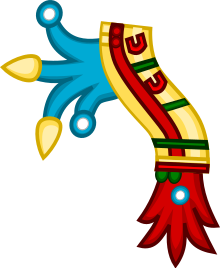Difrasismo
From Wikipedia, the free encyclopedia
From Wikipedia, the free encyclopedia
Difrasismo is a term derived from Spanish that is used in the study of certain Mesoamerican languages, to describe a particular grammatical construction in which two separate words are paired together to form a single metaphoric unit. This semantic and stylistic device was commonly employed throughout Mesoamerica,[1] and features notably in historical works of Mesoamerican literature, in languages such as Classical Nahuatl and Classic Maya.
The term was first introduced by Ángel María Garibay K.[2]

For example, in Nahuatl the expression cuitlapilli ahtlapalli or in cuitlapilli in ahtlapalli, literally 'the tail, the wing', is used in a metaphoric sense to mean 'the people' or 'the common folk'. The Aztecs' term in xochitl in cuicatl ['flower and song'] could refer to any artistic endeavor in general and the effect of the divine force teotl.[3] The pair in tonan, in tota ['our mother, our father'] (which in classical Nahuatl is the only gender-neutral way to refer to a "parent") is often part of an invocation to a high god.[4] The atl-tlachinolli ['water, burnt-earth'] or atlachinolli pairs the elemental opposites of water and fire (each a force for both life and destruction) into a single symbol of war.[5]
Seamless Wikipedia browsing. On steroids.
Every time you click a link to Wikipedia, Wiktionary or Wikiquote in your browser's search results, it will show the modern Wikiwand interface.
Wikiwand extension is a five stars, simple, with minimum permission required to keep your browsing private, safe and transparent.